News
Talking foreign: 40 of the most commonly mispronounced food words
Wednesday, June 25th, 2014At a music festival in Scotland in 2003, I ambled up to a food truck to procure the necessary beer-absorbent dinner. After attempting to order a behr-gehr three times in my flat Saffa accent and receiving nothing but a perplexed look, I put on my best Scots brogue and asked instead for a barr-garr. Success! (Yes, it was worse when I tried to ask for a kirk. The sugary caffeinated beverage is better known as a cork in Scotland.) The point is: it’s pretty important to be able to pronounce your food – if you want to get the right thing into your mouth anyway. To assist you in avoiding culinary embarrassment and/or starvation, we’ve gathered a list of the most tricky food words and give you a handy – and extremely silly, if you read it aloud as intended – phonetic guide to rolling your tongue over the syllables. Enjoy!
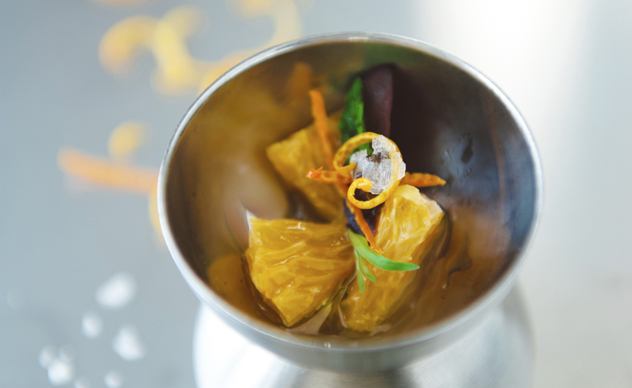
An amuse bouche. Photograph: iStock
Amuse bouche
Ah-mooz boosh
What is it: A small taste of something to amuse the palate, usually served at a fine dining restaurant before a multiple course meal.
How not to say it: Ah-moo-say bowch
Boerewors
Boo-ruh-vorrs
What is it: A traditional South African spiced sausage made predominantly with beef, but also pork and/or lamb. Best when braaied to perfection. (Read our tips from the country’s top braai masters.)
How not to say it: Bo-uh-ree-wers
Boeuf bourguignon
Berf boor-geen-yon
What is it: A slow-cooked Burgundy dish (made popular with homecooks by Julia Child in the 1960s) of beef braised in red wine and herbs.
How not to say it: Bee-oof bow-gweeg-non
Bobotie
Buh-booah-tea
What is it: A traditional Malay South African dish of gently spiced beef mince (sometimes containing dried fruit), topped with an eggy custard before being baked in the oven. Especially good served with nostalgic favourite Mrs Balls Chutney.
How not to say it: Bow-bow-tee
Bouillabaisse
Boo-yah-bez
What is it: A fragrant fish stew from the Provence region of France, using bony fish (difficult to sell at markets by local fisherman) and the region’s herbs and spices.
How not to say it: Boo-eeh lah-base or boo-lah-bayz
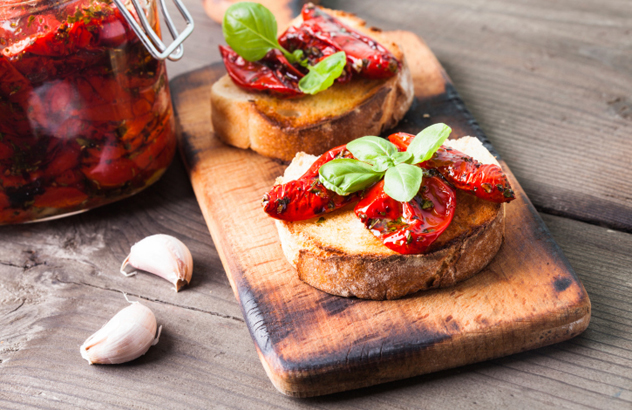
Bruschetta with sundried tomatoes. Photograph: iStock.
Bruschetta
Broo-sketta
What is it: Fancy toast, usually made from slices of baguette rubbed with a clove of garlic and then grilled in the oven.
How not to say it: Brushetta (Yep, we thought we were being fancy by saying ‘sh’ instead of ‘k’ too.)
Buchu
Boo-ghoo (soft ‘g’)
What is it: A detoxifying herb, popular in teas, that has been used in South Africa for centuries.
How not to say it: But-chew
Caipirinha
Kay-pee-reen-ya
What is it: Brazil’s national cocktail made with cane, lime and sugar. (See our list of where to watch the Brazil World Cup.)
How not to say it: Kai-pur-rinna
Chipotle
Chee-pot-leh
What is it: A smoked and dried jalapeño chilli.
How not to say it: Chip-ottle
Chorizo
Choh-reet-zo
What is it: Spanish and Portuguese cured pork sausage commonly containing smoked red peppers.
How not to say it: Cho-rizzo
Ciabatta
Cha-baa-tah
What is it: Italian bread baked in a long, flat loaf with a loose and airy crumb.
How not to say it: See-ah-batter
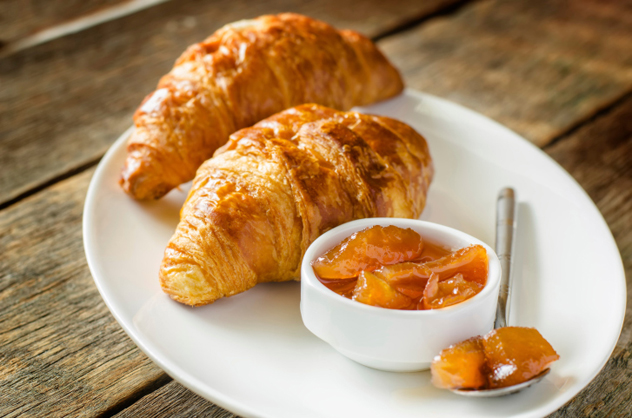
It’s also acceptable to serve these pastries with bacon and Nutella. Photograph: iStock.
Croissant
Kwah-son
What is it: Buttery pastry rolled up and curved into a sickle moon shape. (Best eaten with lashings of Nutella.)
How not to say it: Croy-sant, cro-see-ont
Dauphinoise
Dor-feen-waz
What is it: A dish of sliced potatoes baked in a creamy garlicky sauce. Locally known as potato bake.
How not to say it: Doff-in-oyz
Gratin
Grah-tahn
What is it: Anything that’s covered in breadcrumbs and cheese and baked to golden, bubbly perfection. Try this recipe for butternut and sage gratin.
How not to say it: Grat-tin
Filet mignon
Fi-ley min-yon
What is it: A cut of beef or pork from the tenderloin.
How not to say it: Fill-it mig-non
Foie gras
Fwa-grah
What is it: Liver of a fattened-up duck, prized for its buttery and rich flavour.
How not to say it: Fooey-grass
Hors d’oeuvres
Or-derve
What is it: Fiddly snacks on a tray which are infuriatingly tricky to eat while holding a glass. (Read our rant about canapés.)
How not to say it: Horse duh-oov-raz
Gnocchi
Nyoh-key
What is it: Traditional Italian dumplings of potato, flour, egg and parmesan. (Try this recipe for roasted butternut and sage gnocchi.)
How not to say it: Guh-no-chee
Jalapeño
Ha-lah-pen-yo
What is it: Large, mild chillies picked when green and commonly used for chilli poppers. (Read our list on where to get chilli poppers.)
How not to say it: Jay-luh pay-no
Mange tout
Monj too
What is it: A type of pea enjoyed when still inside the thin-skinned pod. (Also known as the sugar snap pea.)
How not to say it: Man-je-towt, man-go towt
Merlot
Mur-loh
What is it: Red red wine. (We trust you know all about this one.)
How not to say it: Mer-lott

It’s a custard slice, innit? Photograph: iStock
Mille feuille
Meel foh-way
What is it: A French dessert that features multiple layers of puff pastry and custard. Mille feuille in French means thousand leaves.
How not to say it: Mill-foily or milly-filly
Mojito
Mo-hee-toh
What is it: A Cuban cocktail comprising rum, lime juice, mint and sugar.
How not to say it: Mo-jee-toe
Morogo
Moh-roh-gho (soft g)
What is it: A leafy vegetable similar to spinach that’s cultivated in Southern Africa. Delicious, as are most vegetables, with butter.
How not to say it: Mow-roggo
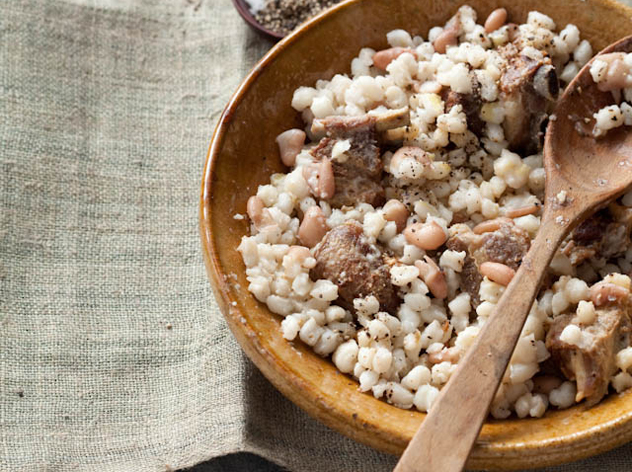
Samp and beans with lamb. Photograph by Russel Smith.
Ngqush (Umngqusho)
N-qoosh (click on the ‘q’)*
What is it: Samp and beans, a dish beloved of Nelson Mandela. (Here’s how to make ngqush at home.)
How not to say it: N-kush
Nicoise
Nee-swaz
What is it: A traditional French salad (originating in Nice) that contains tuna, boiled egg, tomatoes and a tangy vinaigrette.
How not to say it: Nee-soyz
Nougat
Noo-gah
What is it: Confectionery made with honey, egg whites and nuts, most commonly found in the form of a bar. (Make your own frozen hazelnut nougat.)
How not to say it: No-ghut
Paella
Pah-yey-ya
What is it: A one-pan Spanish dish of rice, seafood, saffron and sausage.
How not to say it: Pie-yella
Proscuitto
Proh-shoot-toh
What is it: Very thinly sliced cured Italian ham.
How not to say it: Pros-kyu-eet-oh
Quesadilla
Ke-sah-dee-yah
What is it: A traditional Mexican tortilla folded in half and filled with meat, cheese and/or salsa.
How not to say it: Kwess-uh-duh-lah
Quiche
Keesh
What is it: An open pie with a savoury filling of vegetables and eggy custard. Great for using up leftovers. (Read the A-Z of leftovers.)
How not to say it: Quickie, kweech
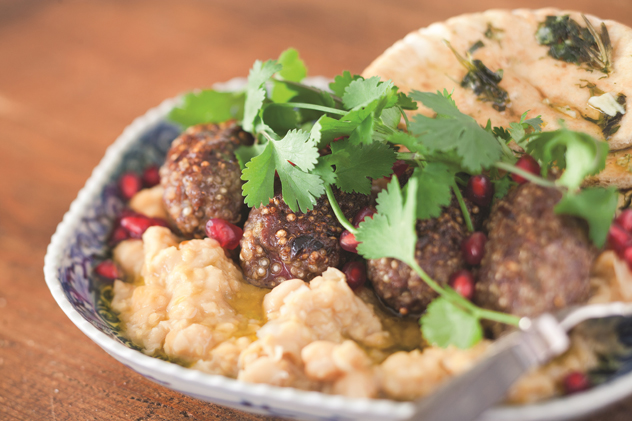
Jane Coxwell’s lamb and quinoa kofta. Photograph courtesy Fresh, Happy, Tasty, published by Harper Collins.
Quinoa
Keen-wah
What is it: A protein-rich grain from Peru that’s popular with health nuts.
How not to say it: Kwin-oh-ah
Ratatouille
Rat-ta too-wee
What is it: A French cooked dish of chopped up brinjals, courgettes and tomatoes. (Also the name of a rat with extraordinary culinary talents in the Pixar film.)
How not to say it: Ra-ta toy-lee
Sake
Sah-ke
What is it: Japanese rice wine.
How not to say it: Sayk
Shisa nyama
Shi-sah nya-mah
What is it: A South African meal of meat cooked on an open fire.
How not to say it: Shy-sa nyay-muh
Thyme
Time
What is it: A popular herb used in cooking, especially with lemon in chicken dishes. (Read our A-Z of herbs.)
How not to say it: thigh-me
Umqombothi
Oom-qom-boh-tee (click on the ‘q’)*
What is it: A traditional home-brewed Xhosa beer made from fermented maize and malt. Creamy and sour tasting, it is drunk on important family celebrations.
How not to say it: Um-kwom-boat-ee
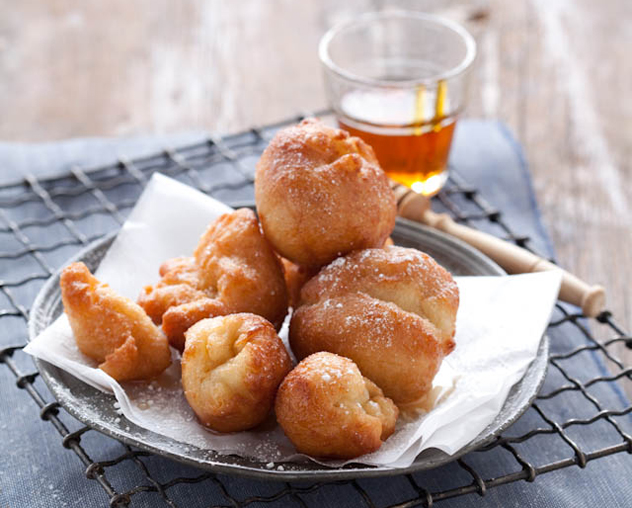
Traditional South African vetkoek. Photograph by Russel Smith.
Vetkoek
Fet-cook
What is it: Traditional South African fried balls of dough with either savoury (minced beef) or sweet (apricot jam) filling. (Make your own vetkoek.)
How not to say it: Vet-koh-ek
Vichyssoise
Vee-shee-swaz
What is it: Cold potato and leek soup.
How not to say it: Vee-chis-oyz
*Learn how to do the Xhosa ‘q’ click in Khaya Dlanga’s video.
We’d love to hear which food words you find most difficult to pronounce. Let us know in the comments below.



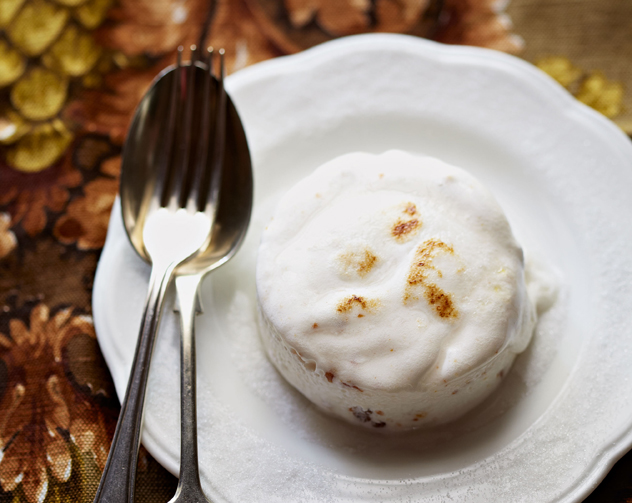
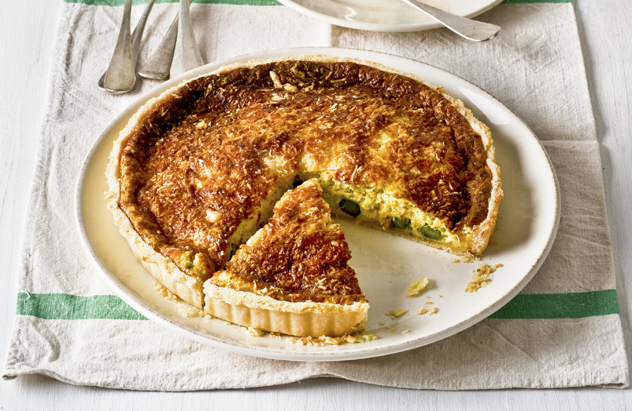










I was enjoying this article until I got to Bruschetta
as it is not Broo-shetta but Broo-sketta as the ‘h’ between the ‘c’ and ‘e’ makes a ‘k’
and ya this is just a fun article but the best way to learn is whilst having fun so making mistakes in such an article will teach someone incorrectly. Then one day we may cross paths and they’ll be talking about bruschetta but I’d think they’re trying to say prosciutto (the ‘i’ between the ‘c’ and ‘u’ makes a ‘sh’) and total confusion will ensue.
No I do not understand much Italian but the most beautiful thing about the language is that if you know your rules (and their aren’t that many) you can pronounce it almost perfectly event though you have no clue what you may be saying.
And yep will not be reading any further in case I incorrectly learn how to say something I do not know how to say.
Though thanks for the Bouillabaisse – wonder why the ‘ll’ is a ‘y’ as from what I know that is spanish pronunciation. Will have to check its etymology 🙂
You are right, Forever21! We have amended the description for bruschetta to reflect the Italian pronunciation. Thanks for your feedback.
Bruschetta is NOT “Bru SH etta but indeed Brus Ketta !!!!!!!!!!!!! ask any Italian!!! “Ch”in Italian is pronounced “K” !!! not SH……
Well spotted, Loretta. All fixed now. All the best
haha great article – shared it immediately as always have to help with the correcting. Also always struggle with Mille feuille… 🙂
Thanks, Birdie! Pleased to be of service.
try “kneidlach” k-ney-d-lach (in the back of the throat!), “perogen” per-og-en, “lokshen” lock-shin, “teiglach” tay-g-lach (back of the throat again!)
all Jewish specialities.
Wow, Carol. Those sound like a mouthful! Thanks for sharing.
Hi guys don’t forget jus!
Ah yes, that’s always a funny one!
I always battle with “Thank you, but I have had a delicate sufficiency”, and ” No more for me’, or “I shouldn’t, but if you insist, well OK pile it on then!”
You’re quite right. The pronunciation gets us every time. 😉
To answer @Forver21, the “ll” is pronounced “ye” in French if there is a “i” before the “ll”, if no “i”, then it is a normal “l” pronunciation!
Great fun article!
I think you guys have the pronounciation of feuille. Unless you meant to say it properly and just wrote it wrong. I was an exchange student in France for a year and this is definitely one of the words I learnt. I don’t know how to write the pronounciation, but this video does it pretty well, except the e isn’t meant to be so promenant at the end. https://m.youtube.com/watch?v=mZVaRau1c_g
Great article! However, I believe the recommended pronunciation for paella is a little off. It should not be pronounced “pah-yey-ya”, but “pah-ey-ya”. I remember this lesson from my professor from Spain.